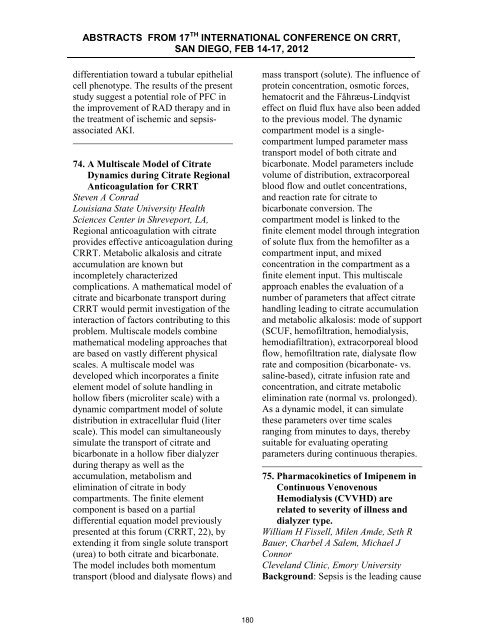ABSTRACTS from 16th International COnference on ... - CRRT Online
ABSTRACTS from 16th International COnference on ... - CRRT Online
ABSTRACTS from 16th International COnference on ... - CRRT Online
Create successful ePaper yourself
Turn your PDF publications into a flip-book with our unique Google optimized e-Paper software.
<str<strong>on</strong>g>ABSTRACTS</str<strong>on</strong>g> FROM 17 TH INTERNATIONAL CONFERENCE ON <strong>CRRT</strong>,<br />
SAN DIEGO, FEB 14-17, 2012<br />
differentiati<strong>on</strong> toward a tubular epithelial<br />
cell phenotype. The results of the present<br />
study suggest a potential role of PFC in<br />
the improvement of RAD therapy and in<br />
the treatment of ischemic and sepsisassociated<br />
AKI.<br />
74. A Multiscale Model of Citrate<br />
Dynamics during Citrate Regi<strong>on</strong>al<br />
Anticoagulati<strong>on</strong> for <strong>CRRT</strong><br />
Steven A C<strong>on</strong>rad<br />
Louisiana State University Health<br />
Sciences Center in Shreveport, LA,<br />
Regi<strong>on</strong>al anticoagulati<strong>on</strong> with citrate<br />
provides effective anticoagulati<strong>on</strong> during<br />
<strong>CRRT</strong>. Metabolic alkalosis and citrate<br />
accumulati<strong>on</strong> are known but<br />
incompletely characterized<br />
complicati<strong>on</strong>s. A mathematical model of<br />
citrate and bicarb<strong>on</strong>ate transport during<br />
<strong>CRRT</strong> would permit investigati<strong>on</strong> of the<br />
interacti<strong>on</strong> of factors c<strong>on</strong>tributing to this<br />
problem. Multiscale models combine<br />
mathematical modeling approaches that<br />
are based <strong>on</strong> vastly different physical<br />
scales. A multiscale model was<br />
developed which incorporates a finite<br />
element model of solute handling in<br />
hollow fibers (microliter scale) with a<br />
dynamic compartment model of solute<br />
distributi<strong>on</strong> in extracellular fluid (liter<br />
scale). This model can simultaneously<br />
simulate the transport of citrate and<br />
bicarb<strong>on</strong>ate in a hollow fiber dialyzer<br />
during therapy as well as the<br />
accumulati<strong>on</strong>, metabolism and<br />
eliminati<strong>on</strong> of citrate in body<br />
compartments. The finite element<br />
comp<strong>on</strong>ent is based <strong>on</strong> a partial<br />
differential equati<strong>on</strong> model previously<br />
presented at this forum (<strong>CRRT</strong>, 22), by<br />
extending it <str<strong>on</strong>g>from</str<strong>on</strong>g> single solute transport<br />
(urea) to both citrate and bicarb<strong>on</strong>ate.<br />
The model includes both momentum<br />
transport (blood and dialysate flows) and<br />
mass transport (solute). The influence of<br />
protein c<strong>on</strong>centrati<strong>on</strong>, osmotic forces,<br />
hematocrit and the Fåhræus-Lindqvist<br />
effect <strong>on</strong> fluid flux have also been added<br />
to the previous model. The dynamic<br />
compartment model is a singlecompartment<br />
lumped parameter mass<br />
transport model of both citrate and<br />
bicarb<strong>on</strong>ate. Model parameters include<br />
volume of distributi<strong>on</strong>, extracorporeal<br />
blood flow and outlet c<strong>on</strong>centrati<strong>on</strong>s,<br />
and reacti<strong>on</strong> rate for citrate to<br />
bicarb<strong>on</strong>ate c<strong>on</strong>versi<strong>on</strong>. The<br />
compartment model is linked to the<br />
finite element model through integrati<strong>on</strong><br />
of solute flux <str<strong>on</strong>g>from</str<strong>on</strong>g> the hemofilter as a<br />
compartment input, and mixed<br />
c<strong>on</strong>centrati<strong>on</strong> in the compartment as a<br />
finite element input. This multiscale<br />
approach enables the evaluati<strong>on</strong> of a<br />
number of parameters that affect citrate<br />
handling leading to citrate accumulati<strong>on</strong><br />
and metabolic alkalosis: mode of support<br />
(SCUF, hemofiltrati<strong>on</strong>, hemodialysis,<br />
hemodiafiltrati<strong>on</strong>), extracorporeal blood<br />
flow, hemofiltrati<strong>on</strong> rate, dialysate flow<br />
rate and compositi<strong>on</strong> (bicarb<strong>on</strong>ate- vs.<br />
saline-based), citrate infusi<strong>on</strong> rate and<br />
c<strong>on</strong>centrati<strong>on</strong>, and citrate metabolic<br />
eliminati<strong>on</strong> rate (normal vs. prol<strong>on</strong>ged).<br />
As a dynamic model, it can simulate<br />
these parameters over time scales<br />
ranging <str<strong>on</strong>g>from</str<strong>on</strong>g> minutes to days, thereby<br />
suitable for evaluating operating<br />
parameters during c<strong>on</strong>tinuous therapies.<br />
75. Pharmacokinetics of Imipenem in<br />
C<strong>on</strong>tinuous Venovenous<br />
Hemodialysis (CVVHD) are<br />
related to severity of illness and<br />
dialyzer type.<br />
William H Fissell, Milen Amde, Seth R<br />
Bauer, Charbel A Salem, Michael J<br />
C<strong>on</strong>nor<br />
Cleveland Clinic, Emory University<br />
Background: Sepsis is the leading cause<br />
180
















